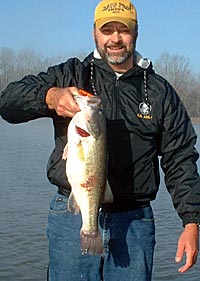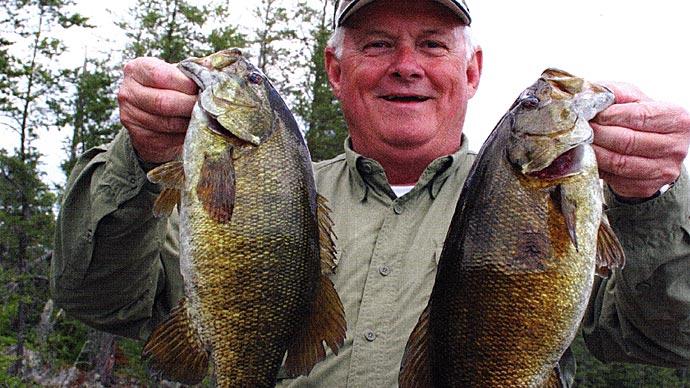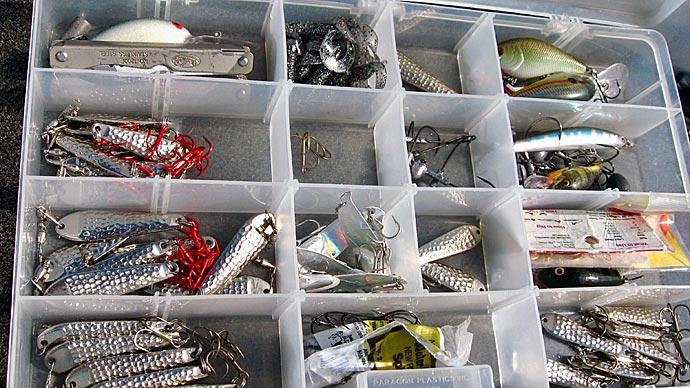
Hot baits are what every bass angler in America wants most from his, or her, local tackle store. Oh, you mean that you do not find yourself walking down every isle looking and digging through lures that nobody else would use? Of course you do, and rightfully so. What determines a hot bait? Most anglers think a bait is hot if it catches numerous fish or a big fish. A particular lure is hot when it's proven to be productive.
There are a number of factors involved in the productivity of a lure that result from conditions rather than the bait itself. Bottom composition of the lake, weather, and water temperature will determine your success during the cold winter months, and year round. Therefore, it is very important to have a good quality fishfinder. An accurate weather report will also help you determine what bait is the most productive. Water temperature, however, will be the main issue in lure selection.
In the winter months, there are numerous baits that are proven to be extremely productive. Jigging spoons, jig-and-pigs or craws, crankbaits, and finesse baits are some of the best.
Jigging Spoons
The jigging spoon is the best winter bait when you are searching for numbers of bass. You can catch the occasional big bass, but more often the jigging spoon will entice bass of average size. Bottom composition is the key element to have success with this bait. Water temperatures dipping into the upper 40's and low 50's will cause bass to move to 20 to 40 feet of water. They'll seek out rock piles, brush piles, or breaklines to hold on through the cold water months.
The best place to locate this type of structure is close to a known spawning area in the depths mentioned. Bass will hold together in deep schools following the shad that have moved to deep water weeks earlier. These bass will usually suspend around any type of structure. Rather than chasing the shad, bass wait for the small fish to move closer to their strike zone.
The jigging spoon works best fished vertically over the top of the structure. Pumping the bait up and down is the most popular method. Timing between the lifting of the rod tip to raise the bait off the bottom and dropping it again will vary. Remember, when working your lure always pay attention to your line on the fall. Most bass will hit the jigging spoon on the fall because it looks like a dying shad that is falling to the bottom. Thus is easy prey, and easy meal.
Jig with Pork or Craw
The jig and pig is one of the best baits in cold water, and year round for catching big bass. This hot bait has been a big bass lure for many years. What makes the jig and pig a favorite among anglers is that it resembles a crawfish, the number one choice of bass looking for a tasty meal.
Jigs are usually fished in heavy cover, rocks, and deep grass beds. They are excellent on drop-offs, too. Large bass tend not to move very far when feeding. But the key to the productivity of a jig and pig is the slow fall and bulk of the bait.
Depths of 5 to 20 feet are usually where big bass tend to concentrate most of their lives. The natural forage in the area will determine color and size combinations when fishing with a jig. Black/blue is the standard color combination to fish. However black/chartreuse and pumpkin/green flake can be productive as well. The Triple Rattle Back jig and Strike King Pro-Model jig are popular, but all jigs are basically similar.
Spray attractants can also be helpful to entice a strike. Especially during colder months when bass are sluggish, the addition of a scent to get the attention of fish is important. Added or already attached rattles also help by emanating sound through the water to get the attention of bass.
A slower presentation will produce more bites in cold water because bass have a tendency to remain dormant. On unusually warm winter days, don't hesitate to move to 5 to 10 feet of water and flip this bait into brush located closer to the channels. Bass will move up to warmer water in the shallower depths.
Another location that is productive on warmer winter days is rip-rap. The bass will move up on the rocks to feed, following the shad that have moved up to feed and warm themselves. Shaking the jig and bouncing it off the rocks can entice a strike from hungry or even just curious bass.
Again, a jig is used by most anglers the majority of the time for catching big bass. It is often a first choice among top tournament anglers.
Crankbaits
Deep diving crankbaits can also be considered a hot bait in the winter months. Bass will tend to become active feeders on warm days between cold fronts that push through. The air temperatures will usually get warmer between cold fronts.
A great starting place for crankbait use is where a lot of rocky points are located. On most lakes you can find these types of areas on the south end of the lake. Areas where the water is clearer will warm first. Clearer water allows heat to get to rocks and deeper water faster because the sun penetrates the water better. Murky water deflects much of the heat from the sun, thereby slowing the penetration of warmth from the sunrays. Depths of 5 to 10 feet are a good choice to throw these baits. Why fish so shallow? Well, under these conditions bass tend to move up and can become active feeders.
Crawfish will be the number one forage for bass this time of year. A 20+ crawfish-colored crankbait is ideal for these conditions. Many lure manufacturers make a 20+-foot crankbaits. The DD-22 crankbait by Norman Lures and the Mann's 20+ are my choices when the weather is like this. Don't hesitate to spray an attractant on your bait. It can entice a finicky bass into striking.
There are basically three reasons for using such a large crankbait. The first one is that the bass know it is worth chasing. A large meal means not having to chase anything else for a while and big bass are basically lazy feeders. Secondly, the large bill and size of the bait allows a slow retrieve. This will make the 20+ stay close to the bottom, where crawfish will be. An added attraction is to cause the bait to dig up a little of the loose bottom and give the appearance of a crawfish making an escape. Finally, the deep-diving crank gives an angler greater casting accuracy due to the weight and size of lure.
Crankbaits can be successful if worked slowly and if Mother Nature gives us a few warm winter days. One of the best tricks with cranks is to fish them where you know other people don't. Fish holding in brushy or timbered areas see a lot less crankbaits than fish holding on points. It can pay off very well to utilize these bulky baits in areas where the fish are less likely to have seen them. Most anglers prefer not to use crankbaits in areas where they are more likely to become hung up, but this can offer you an advantage if you have the patience to give it a try.
Finesse Baits
Small, soft plastic grubs can be very hot baits in cold water. Bottom composition is again the key to catching bass with finesse baits.
These small baits work extremely well along bluffs on deep-water lakes for smallmouth and largemouth bass. Points with rock piles and brush piles are excellent locations for catching fish.
Ultra-light equipment is best when fishing finesse baits. A good 6-foot, one-piece spinning rod is my choice for working these lures. Monofilament fishing line in the 8-to-pound test range is great for feeling the soft bite that you will get when fishing these lures in cold water.
A lead jig head in 1/8- to ¼-ounce is the perfect size, depending on the wind. A 3-inch salt and pepper-colored grub by Kalin is an outstanding grub to use. Chartreuse or white grubs are excellent, too.
What makes this bait hot is that the shad will bunch up in winter and suspend over the bottom compositions mentioned. They will be suspended close to the shad and feed on them when the shad get close to their strike zone.
Electronics are a must when looking for these schools of shad. Once the school is found, work the lure by swimming it through the schools of bass that will be found in the general area of the shad. Hopping the grub up and down can also entice a bass into striking. Remember to work the bait slower than normal. The bass will have to be tricked into biting during the winter months.
The jigging spoon, jig-and-pig or craw, crankbaits, and finesse baits are very successful during the winter months using the described techniques. Remember, what makes a hot bait is determined by bottom composition, weather conditions, and water temperature. Winter months can be great, especially because you will not have to fight for a spot to fish. Fish must feed year round.
Dress to the fishing conditions. Wear, and take, more worm clothing than you think you will need. Have plenty of extra socks and other items with you so that if you get wet you can change to dry clothing promptly. Carry plenty of hot coffee or other warm beverages with you to help give a little warmth from the inside. Some anglers have begun using hand warmers that can be slipped in pockets and inside coats and even carry small propane heaters for quick warm-ups.
Always let someone know when you're going fishing and when you can be expected back during these months. Hypothermia can kill you very quickly. All it takes is falling into the frigid water for just a few seconds. With cold-water temperatures, you must stay dry and be prepared.
Good luck and God bless.




